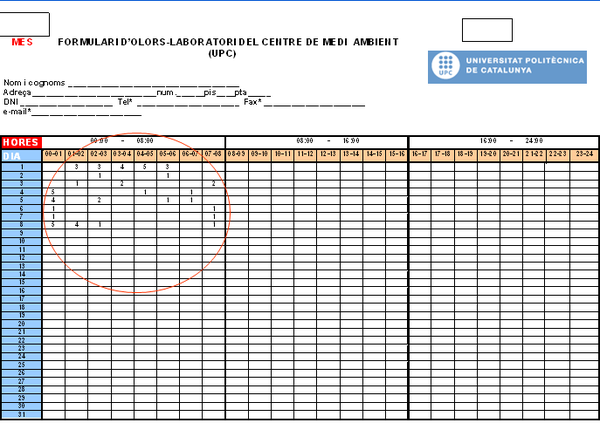Social control
To evaluate the impact of odour episodes, the identification of the concrete compounds that generate them is needed. Hence, the employment of a sampling methodology that would allow a capture of VOC both in short and long lasting episodes is required. When odour episodes are not constant and short, the presence of a technician is generally required to start the sampling. However, in these cases, a great number of times the episode is over when the specialist arrives the place. In order to avoid this drawback, LCMA has developed a procedure based on social control, where the affected people are the ones that activate the sampler through remote control (Figure 1). Additionally, the exact time of start and stop of the sampler has to be recorded. To optimize analytical costs, the sampling has to start when odorous episodes are at its maximum intensity. The sampling process is completed with a sensorial registry (Figure 5) (Roca, 2006, Gallego et al, 2011, 2013).
- Roca, F.J., “Disseny d’un sistema de control d’olors i de la qualitat de l’aire. Caracterització, quantificació i assignació de l’origen de compostos orgànics volàtils (COV)”. Doctoral thesis-UPC, 2006
- Gallego, E, Roca, F.J., Perales, Guardino, X., “Assessment of chemical hazards in sick building syndrome situations. Determination of concentrations and origin of VOCS in indoor air environments by dynamic sampling and TD-GC/MS analysis”, Springer, ISBN 978-3-642-17918-1p. 289-334, (2011)
- Gallego, E., Roca, F.J., Guardino, X., Rosell, M.G., Gadea, E., “Calidad del aire interior: compuestos orgánicos volátiles, olores y confort”, NTP 972, Instituto Nacional de Seguridad e Higiene en el Trabajo (INSHT), NIPO : 272-13-036-3
Figure 5. Odour episodes registry (Roca, 2006) |
Data treatment from episodes allows us to:
- Calculate the Annoyance Index in different control points. Generation of an annoyance map
- Follow the evolution of the odorous episodes depending on the meteorological conditions
- Calculate the episode roses (predominant wind directions of the emission sources)
- Determination of the origin of known and unknown activities that are potentially generators of odorous episodes
Figure 6. Annoyance index map (AI) and episode rose map |
ANNOYANCE INDEX
The application of the VDO 3883 Part 2 standard allows the determination of the Annoyance Index (AI) through sensorial data from social control registries. The calculated values (0-100%) permit the evaluation of the annoyance degree of the affected population and their comparison with quality criteria at international level (Germany, The Netherlands, Australia/New Zealand). The graphic representation of the AI would help in the identification of the emission source.
odorous episodes from an urban solid waste landfill |
|
EPISODE ROSES. ORIGIN DETERMINATION
The study of the meteorological conditions before, during and after the detection of an odorous episode allows, following the VDI 3940 standard, the assignation of the corresponding origin directions and frequencies to the episodes (episode roses). The graphical representation of the episode roses in each of the sampling points will determine the coincident origins of the known emission sources in a first level. Additionally, this representation will show unknown emission sources.
|
maximum impact zones in the urban area (impact map obtained through numerical modelling) |











Share: